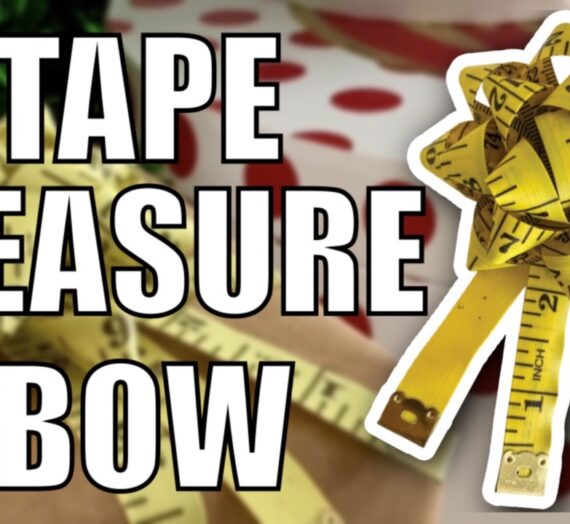When a friend of mine moved into her new house, the previous owner had left behind some old lace curtains. My friend was going to throw them out, but gave them too me instead. I wasn’t sure what I was going to make, but after playing around with the fabric for a little while, I decided that a tiered skirt with some puff sleeves would suit the fabric, and I had just enough material.

This dress was really easy to make because all of the shirring and gathering is done with elastic. Here’s how I took these old lace curtains and turned them into an pretty off-the-shoulder tiered dress.

There were several areas where the lace was tattered and coming undone, as well as a few rips and tears in the sheer fabric. I started out by mending some of the bits of lace, and marking the rips with safety pins so I could easily avoid those areas when cutting out the pieces for my dress.

These curtains had stripes or lace going horizontally across the curtains, with areas of sheer fabric in between. I wanted to use the lace at the bottom edge of tiers on a skirt. Before I started cutting anything, I took Fray Check and applied it to the entire bottom edge of the lace. After it dried, I carefully cut about 1/8 inch away from the lace on the bottom edge. I left the sheer fabric above the lace attached, but cut a straight line across the top. This left me with with sections fo fabric that were the perfect dimensions to create a tiered skirt.

I used French seams to join my skirt pieces, then sewed across the top waistband edge to hold all of the layers together. Since each tier has a Fray Checked lace edge at the bottom there’s no need to hem.

To create the bodice of my dress, I cut out four rectangles. I treated two of the rectangles like the main exterior fabric fo the dress, and the other two became the lining of the bodice. First, I sewed the side seams using French seams, then I sewed around the entire circumference of the top edge of the bodice. Then I under-stitched the lining side so that there would be a clean turned edge at the top of the bodice.

Next, I sewed horizontal lines across my bodice to create channels for elastic. Each channel was sewn at 3/8 inch wide because I used 1/4 inch wide elastic. The first channel was sewn at the top edge of the dress. Then I measured down 7 inches and started adding more channels that were spaced about 1 inch apart. The 7 inch gap was the right amount of space for my bust area, but you may need more or less depending on your size. For each channel, I left about 1 to 2 inches of space between the start and stopping point of each stitching line. This allowed me to place elastic in each casing, starting from the top edge. Figuring out how long I needed my elastic took a bit of trial and error. I measured out elastic to be a couple inches smaller than my chest and waist measurements, then ended up subtracting several more inches from the length to give a snugger fit. After installing each elastic band, I stitched the channel closed the rest of the way. In retrospect, it would have been easier to leave an opening in the side seam of the bodice instead, but this method still produced a beautiful result.

After completing the bodice, I was ready to join the skirt to the bodice. I marked the skirt and bodice every 1/4 of the way around of the circumference, matched up the markings, and sewed the pieces together using a 5/8 inch seam allowance. I finished this seam allowance using my serger, but I didn’t let the serger cut off any of the seam allowance. This is because I used the seam allowance to create one last casing for elastic. Turning the seam allowance up towards the bodice, I stitched at 3/8 inch away from the waist seam, ending my stitching about 1 to 2 inches away from the start. Then I added one final band of elastic and stitched the opening closed.
The puff sleeves were made with rectangles that I cut at about double the circumference of my arm. I sewed the short sides together with French seams, then added a wide rolled hem to each remaining edge. I left enough room in my rolled hem to create a casing for elastic on both the top and bottom. After adding elastic, I tried the puff sleeve on my bicep area and ended up having to tighten it more so that the sleeve stayed up. The last step for the sleeves is to tack the sleeve onto the dress at the side seam.

Once I tried my dress on at this point, I realized that I hadn’t taken the back of the dress into consideration. The bodice had plenty of room for my bustline. However, the back of the bodice now had a big bulge that was very unattractive. If I were to remake this dress, I would plan to make the entire back of the dress have shirring/ elastic casings all the way up instead of leaving the 7 inches of space that is necessary over the bust. Since the dress was already sewn altogether, I was definitely not going to take it all apart just to add a few bits of elastic.

My solution was to add some spaghetti straps, and tack the gathering of the bodice in strategic places. This ended up working out really well because it also helped me eliminate excess volume at the side seams of my bodice too. Basically, I pushed the gathers at the top edge of the bodice towards the center front, then stitched vertically over the elastic band to prevent the gathers from moving back to their original place. I used 1” strips fo fabric double-folded and top-stitched to create some quick straps. To figure out where to place them, I tried on the dress and marked the best strap placement with an erasable pen. Then I stitched the straps in place.

I had such a fun time making this dress, and I definitely learned some things along the way. Wearing this dress makes me feel like I’m living in a fairy tale. What were once old, discarded curtains are now a gorgeous dress. Scroll down to see more photos and video of my dress making process.

If you follow this tutorial or create something similar for yourself, tag me on social media @SincerelySews. I love seeing what others create. Happy Sewing! xoxo
Any product links in this post are not sponsored and are provided only for your convenience.




